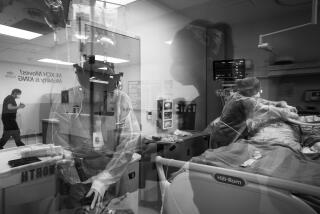Stroke rate is climbing in HIV-positive people
- Share via
While the overall stroke rate in the United States has declined in the last decade, the rate among people infected with the AIDS virus has climbed sharply, researchers reported Wednesday. Although the reason for the increase is not clear, many experts suspect that it is related to the use of protease inhibitors to control replication of the virus. While the drugs, as part of cocktails of antiretroviral medications, have proved remarkably effective in controlling the virus and prolonging patients’ lives, they have also interfered with the patients’ lipid metabolism, increasing the levels of cholesterol and lipids in patients’ blood and altering the distribution of fats in their bodies. Some experts suspect the drugs have also led to an increase in heart attacks among HIV-positive individuals, but that has not been demonstrated.
Dr. Bruce Ovbiagele of the UC San Diego School of Medicine and Dr. Avindra Nath of Johns Hopkins University reviewed a national dataset of all hospitalized patients whose primary diagnosis was stroke between 1997 and 2006. They reported in the online edition of the journal Neurology that, in the general population, the incidence of stroke fell 7%, from 998,739 cases in the first year of the study to 926,997 cases in the final year. During the same time period, however, the incidence of stroke among HIV-positive people rose about 60%, from 888 cases to 1,425. Moreover, all of the increase was in ischemic stroke -- strokes caused by blood clots in the brain -- and none in strokes caused by bleeding.
Some of the increase could be caused by increased survival of the patients, they conceded. Stroke is primarily a disorder of the elderly, and the HIV drugs allow victims to live longer. But the majority of the HIV-positive stroke victims in their study were in their 50s, the researchers said, suggesting that either the disease or the drugs were playing a role in the clotting. The researchers cautioned HIV physicians to be particularly alert to symptoms that might indicate that a patient is at above-normal risk for a stroke. They noted, however, that even with the increased risk, the absolute risk of stroke was still very low, less than 0.2%.




